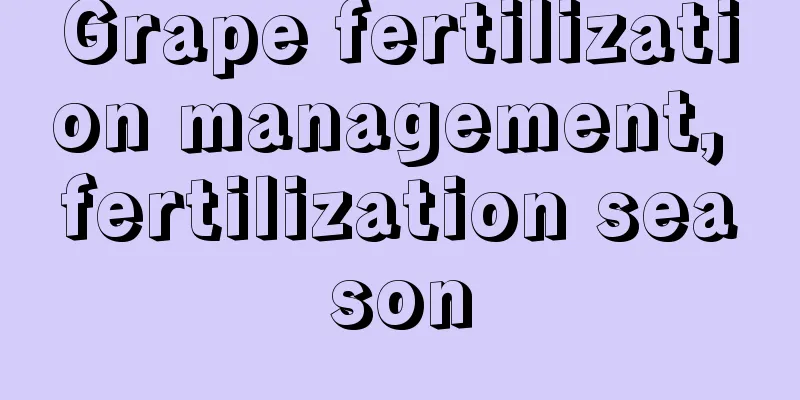Grape fertilization management, fertilization season

1. Base fertilizerBasal fertilizer is also called base fertilizer, and the total amount of fertilizer applied accounts for more than 70% of the whole year. The main thing is to apply organic fertilizer, use 800-1000 kg of decomposed manure, and do it after the fruit is harvested, which will have a better effect. Applying nutrients at this time can replenish the nutrients consumed by fruiting, help restore the tree's vigor, and enhance its cold resistance, which is beneficial for wintering and next year's growth and flowering. The specific location and depth of fertilization should be determined according to the size of the plant. For younger plants, the fertilizer can be placed closer to the root system; for older plants, the fertilizer should be placed farther away to avoid damaging the roots. Dig a hole of appropriate size, put the fertilizer in, and cover it with soil. 2. Topdressing1. Germination fertilizer: Germination fertilizer is applied in early spring, probably after February each year, mainly nitrogen fertilizer. Apply 20 kg of urea and 10 kg of superphosphate per mu, either in furrows or holes. 2. Fertilizer before flowering: Fertilizer before flowering is applied in late April every year, mainly applying phosphorus fertilizer and nitrogen fertilizer. Use 15 kg of urea and 10 kg of superphosphate per mu, and water as soon as possible to dilute the fertilizer. 3. Fruit-strengthening fertilizer: This should be applied during the growth period of young fruits. This is the peak period for fertilizer demand, so more fertilizer should be applied. Use 30 kg of urea and 40 kg of potassium sulfate per mu, and the method can be either ditch application or hole application. 4. Coloring fertilizer: Coloring fertilizer is also called ripening fertilizer. The amount of fertilizer is not needed too much at this time. Apply 5-10 kg of potash fertilizer per acre and 2-3 kg of magnesium sulfate. |
<<: How to pollinate and manage grape flowering
>>: Cultivation techniques of fortune tree
Recommend
Soak the chestnuts in water, they will sprout in 7 days and emerge as seedlings in 30 days. When they grow into potted plants, they are more beautiful than green radish!
Now life has become more convenient. Many snack m...
Lotus root planting conditions and climate requirements
Lotus root planting conditions Lotus root is a li...
How to grow cloud bamboo so that it grows vigorously?
As an indoor ornamental plant, although cloud bam...
When is the best season to plant bougainvillea? When is the best month to plant bougainvillea?
The cultivation of Bougainvillea requires loose s...
What fertilizer is good for peach trees?
Time for topdressing peach trees 1. Basal fertili...
Soil preparation methods for Clivia at different times
Soil matching for Clivia seedlings During the see...
Mint cultivation methods and precautions
1. Breeding methods 1. Soil: The requirements for...
How to take care of the money tree?
Money Tree Growing Conditions For the money tree,...
Why is the fortune tree shedding leaves?
1. Excessive watering 1. Reason: The money tree p...
How to sow purchased lettuce seeds
Basic information on sowing lettuce Lettuce is a ...
Is it feasible to grow money grass in water? How to grow money grass in water
1. Is water culture feasible? It is feasible to g...
How to distinguish summer, winter, spring and autumn types of succulents
Summer type Summer type is a type of succulent th...
The difference between scutellaria baicalensis and shepherd's purse
1. Leaf Difference The leaves of the spathiphyllu...
How to prune yew bonsai
1. Pruning method 1. Bud removal: After the yew b...
How to prune Rieger Begonia after flowering
1. Prune the remaining flowers The flowering peri...









